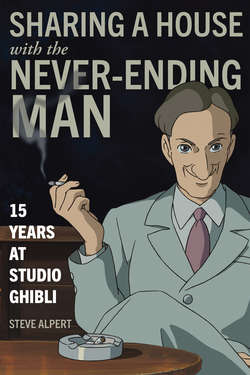Читать книгу Sharing a House with the Never-Ending Man - Steve Alpert - Страница 5
На сайте Литреса книга снята с продажи.
ОглавлениеINTRODUCTION
Studio Ghibli
Studio Ghibli was for more than three decades Japan’s best known and most successful creator of hand-drawn feature-length animated motion pictures. Its huge success has been both artistic and commercial. Since its founding in 1984 Ghibli has produced more than twenty feature films, including Spirited Away, winner of an Academy Award for Best Animated Feature and a Golden Bear for Best Picture at the Berlin International Film Festival—and the most commercially successful Japanese film ever made. Other Ghibli films, including Princess Mononoke, My Neighbor Totoro, Kiki’s Delivery Service, and Grave of the Fireflies, have smashed box office records, won numerous awards, and influenced generations of filmmakers and moviegoers young and old.
Studio Ghibli was founded by the directors Hayao Miyazaki and Isao Takahata, the producer Suzuki Toshio, and Yasuyoshi Tokuma, who was the head of Ghibli’s former parent company, the Tokuma Shoten Publishing Company. Nausicaä of the Valley of the Wind, the studio’s first film, is a tale of a dystopian future in which the world’s ecosystems have been decimated. It was the first Japanese feature-length animated film to draw over a million people to the movie theaters, proving that a commercially viable studio could be created to make only feature-length theatrical animation.
Studio Ghibli’s films have influenced and inspired both animated and live-action filmmakers worldwide. Reflections and versions of images originally created by Hayao Miyazaki can be found in the films of well-known independent and Hollywood motion picture directors, including some major box office hits. Hayao Miyazaki has been called the Walt Disney and the Steven Spielberg of Japanese film. His influence on other filmmakers has been enormous.
Studio Ghibli is located in the leafy residential suburb of Koganei in the western part of Tokyo. Visitors are surprised by its size (small). The studio has made twenty-two feature-length animated films since its inception, and director Hayao Miyazaki is currently working on the studio’s twenty-third.
1.Nausicaä of the Valley of the Wind (1984)
2.Castle in the Sky (1986)
3.My Neighbor Totoro (1988)
4.Grave of the Fireflies (1988)
5.Kiki’s Delivery Service (1989)
6.Only Yesterday (1991)
7.Porco Rosso (1992)
8.The Ocean Waves (1993)
9.Pom Poko (1994)
10.Whisper of the Heart (1995)
11.Princess Mononoke (1997)
12.My Neighbors the Yamadas (1999)
13.Spirited Away (2001)
14.The Cat Returns (2002)
15.Howl’s Moving Castle (2004)
16.Tales from Earthsea (2006)
17.Ponyo (2008)
18.The Secret World of Arrietty (2010)
19.From Up on Poppy Hill (2011)
20.The Wind Rises (2013)
21.The Tale of Princess Kaguya (2013)
22.When Marnie Was There (2014)
23.How Do You Live? (2020)
For about fifteen years beginning in 1996 I was a senior executive at Studio Ghibli and a member of the studio’s board of directors. I was the only gaijin (foreigner) in a very traditional Japanese company.
When I graduated from business school in 1981, a business computer was something that was very large and that you kept in a basement. Only qualified technicians could operate them. They were fed cardboard punch cards that the user gave the tech guys in the late afternoon and then waited until the next day for the results. Computer technology has advanced somewhat since then. The Japanese way of doing business, on the other hand, for the most part has not. It still retains elements popular in the 1800s or earlier.
In most American business schools professors taught (and may well still teach) that Japan is a country populated by people who are arguably the world’s most ideal employees. They were said to possess a world-beating tolerance for hard work and long hours. Their dedication to their jobs and their companies meant that even ordinary assembly-line workers analyzed their own work processes and offered suggestions for improving them and making them even more efficient.
American business school students were urged to emulate the innovative business practices of Japanese companies. Ideas such as the lifetime-employment system and the just-in-time manufacturing process were raised as examples of business practices that gave Japanese companies a competitive edge and made them successful.
For a long time Japan was the world’s number-two economy, although recently it has been surpassed by China. Japan had maintained its position despite its small size, relatively small population, and lack of natural resources. So when I first joined a Japanese company, I looked forward to seeing all the things I’d been hearing about in actual practice. What a shock it was to discover that almost none of it was true.
Finally, a brief word about the title of this book. The Never-Ending Man: Hayao Miyazaki is a 2016 Japanese television documentary film directed by Kaku Arakawa. The name “The Never-Ending Man” refers to Hayao Miyazaki and was coined to describe him by his long-time producer Toshio Suzuki. The title in Japanese, Owaranai Hito, is a bit more nuanced. It might be better translated as “The Man Who’s Never Finished,” a subtle reference to Miyazaki’s feeling that his films are never finished and that, but for the demands of the business of cinema and meeting screening deadlines, he might never finish a film. It also carries the meaning of a man who is never finished making films.
I wanted to use this title for my book because when I saw the documentary it seemed exactly what it felt like for me to work at Studio Ghibli. The camera in the documentary could have been me, right down to the early morning conversations over coffee in the kitchen in Miyazaki’s atelier, where my office at Ghibli was for most of the time I worked there.
